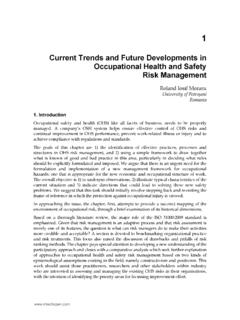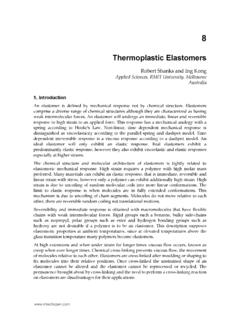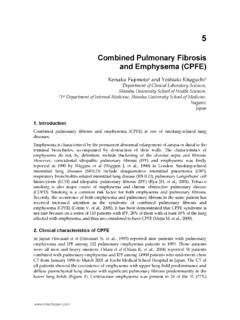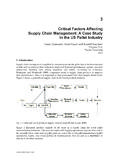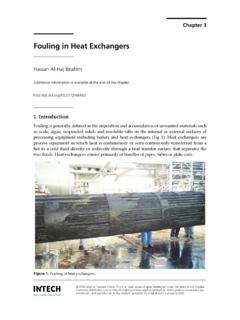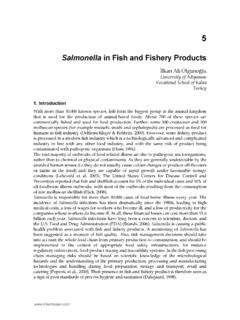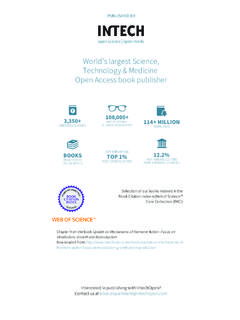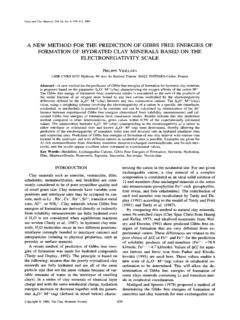Transcription of A Prediction Model for Rubber Curing Process - InTech - …
1 7. A Prediction Model for Rubber Curing Process Shigeru Nozu1, Hiroaki Tsuji1 and Kenji Onishi2. 1 Okayama Prefectural University 2 Chugoku Rubber Industry Co. Ltd. Japan 1. Introduction A Prediction method for Rubber Curing Process has historically received considerable attention in manufacturing Process for Rubber article with relatively large size. In recent years, there exists increasing demand for simulation driven design which will cut down the cost and time required for product development. In case of the Rubber with relatively large dimensions, low thermal conductivity of the Rubber leads to non-uniform distributions of the temperature history, which results in non-uniform cure state in the Rubber .
2 Since Rubber Curing Process is an exothermic reaction, both heat conduction equation and expressions for the Curing kinetics must be solved simultaneously. Summary of previous works In general, three steps exist for Rubber Curing Process , namely, induction, crosslinking and post-crosslinking ( Ghoreishy 2009). In many previous works, interests are attracted in the former two, and a sampling of the relevant literature shows two types of the Prediction methods for the Curing kinetics. First type of the method consists of a set of rate equations describing chemical kinetics.
3 Rubber Curing includes many complicated chemical reactions that might delay the modelling for practical use. Coran (1964) proposed a simplified Model which includes the acceleration, crosslinking and scorch-delay. After the Model was proposed, some improvements have been performed ( Ding et al, 1996). Onishi and Fukutani (2003a,2003b) performed experiments on the sulfur Curing Process of styrene butadiene Rubber with nine sets of sulfur/CBS concentrations and peroxide Curing Process for several kinds of rubbers. Based on their results, they proposed rate equation sets by analyzing the data obtained using the oscillating rheometer operated in the range 403 K to 483 K at an interval of 10 K.
4 Likozar and Krajnc (2007) proposed a kinetic Model for various blends of natural and polybutadiene rubbers with sulphur Curing . Their Model includes post- crosslinking chemistry as well as induction and crosslinking chemistries. Abhilash et al. (2010) simulated Curing Process for a 20 mm thick Rubber slab, assuming one-dimensional heat conduction Model . Likazor and Krajnc (2008, 2011) studied temperature dependencies of relevant thermophysical properties and simulated Curing Process for a 50 mm thick Rubber sheet heated below, and good agreements of temperature and degree of cure have been obtained between the predicted and measured values.
5 152 Heat Transfer Engineering Applications The second type Prediction method combines the induction and crosslinking steps in series. The latter step is usually expressed by an equation of a form d /d = f( ,T), where is the degree of cure, is the elapsed time and T is the temperature. Ghoreishy (2009) and Rafei et al. (2009) reviewed recent studies on kinetic models and showed a computer simulation technique, in which the equation of the form d /d = f( ,T) is adopted. The form was developed by Kamal and Sourour (1973) then improved by many researchers ( Isayev and Deng, 1987) and recently the power law type models are used for non-isothermal, three- dimensional design problems ( Ghoreishy and Naderi, 2005).
6 Temperature field is governed by transient, heat conduction equation with internal heat generation due to the Curing reaction. Parameters affecting the temperature history are dimensions, shape and thermophysical properties of rubbers. Also initial and boundary conditions are important factors. Temperature dependencies of relevant thermophysical properties are, for example, discussed in Likozar and Krajnc (2008) and Goyanes et al.(2008). Few studies have been done accounting for the relation between Curing characteristics and swelling behaviour ( Ismail and Suzaimah, 2000).
7 Most up-to-date literature may be Marzocca et al. (2010), which describes the relation between the diffusion characteristics of toluene in polybutadiene Rubber and the crosslinking characteristics. Effects of sulphur solubility on Rubber Curing Process are not fully clarified ( Guo et al., 2008). Since the mechanical properties of rubbers strongly depend on the degree of cure, new attempts can be found for making a controlled gradient of the degree of cure in a thick Rubber part ( Labban et al., 2007). To challenge the demand, more precise considerations for the Curing kinetics and Process controls are required.
8 Objective of the present chapter As reviewed in the above subsection, many magnificent experimental and theoretical studies have been conducted from various points of view. However, few fundamental studies with relatively large Rubber size have been done to develop a computer simulation technique. Nozu et al. (2008), Tsuji et al. (2008) and Baba et al. (2008) have conducted experimental and theoretical studies on the Curing Process of rubbers with relatibely large size. Rubbers tested were styrene butadiene rubbers with different sulphur concentration, and a blend of styrene butadiene Rubber and natural Rubber .
9 Present chapter is directed toward developing a Prediction method for Curing Process of rubbers with relatively large size. Features of the chapter can be summarized as follows. 1. Experiments with one-dimensional heat conduction in the Rubber were planned to consider the Rubber Curing Process again from the beginning. Thick Rubber samples were tested in order to clarify the relation between the slow heat penetration in the Rubber and the onset and progress of the Curing reaction. 2. The rate equation sets derived by Onishi and Fukutani (2003a,2003b) were adopted for describing the Curing kinetics.
10 3. Progress of the Curing reaction in the cooling Process was studied. 4. Distributions of the crosslink density in the Rubber were determined from the equation developed by Flory and Rehner (1943a, 1943b) using the experimental swelling data. 5. Comparisons of the distributions of the temperature history and the degree of cure between the Model calculated values and the measurements were performed. A Prediction Method for Rubber Curing Process 153. 2. Experimental methods The most typical Curing agent is sulfur, and another type of the agent is peroxide ( Hamed, 2001).
